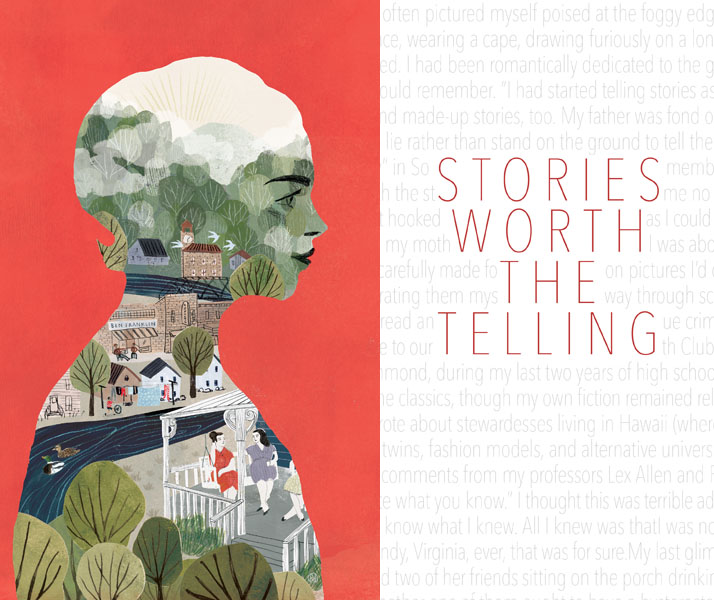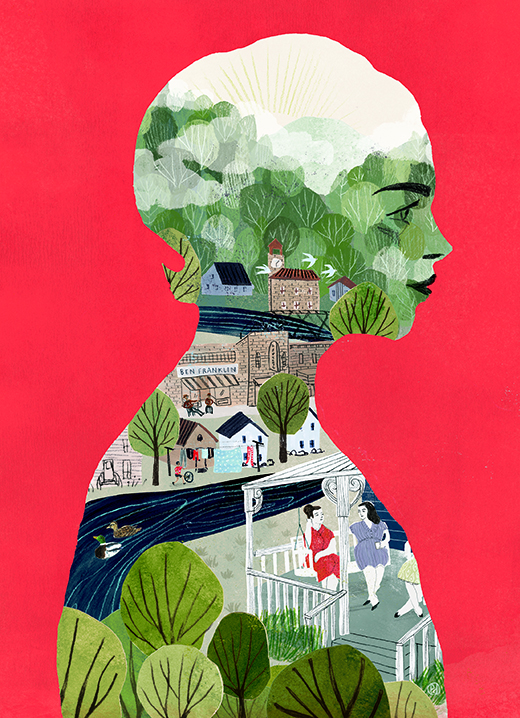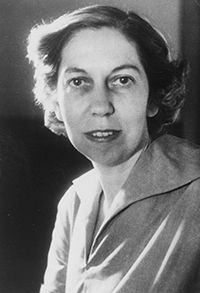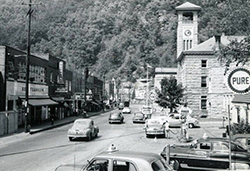
Stories Worth the Telling
It took Lee Smith ’67 some time to find her true voice. Meeting Eudora Welty at Hollins was a turning point in her writing life.

Illustration by Penelope Dullaghan
Although I don’t usually write autobiographical fiction, the main character in one of my short stories sounds suspiciously like the girl I used to be: “More than anything else in the world, I wanted to be a writer. I didn’t want to learn to write, of course. I just wanted to be a writer, and I often pictured myself poised at the foggy edge of a cliff someplace in the South of France, wearing a cape, drawing furiously on a long cigarette, hollow-cheeked and haunted. I had been romantically dedicated to the grand idea of ‘being a writer’ ever since I could remember.”
I had started telling stories as soon as I could talk—true stories, and made-up stories, too. My father was fond of saying that I would climb a tree to tell a lie rather than stand on the ground to tell the truth. In fact, a lie was often called a “story” in Southwest Virginia, and well do I remember being shaken until my teeth rattled with the stern admonition “Don’t you tell me no story, now!”
But I couldn’t help it. I got hooked on stories early, and as soon as I could write, I started writing them down, first on my mother’s Crane stationery when I was about nine, later in little books with covers I carefully made for them, pasting on pictures I’d cut out of magazines or catalogs, or illustrating them myself. I wrote my way through school, fueled by my voracious reading. I’d read anything: mysteries, romances, true crime, science fiction, all the books that came to our house from the Book of the Month Club. Finally at St. Catherine’s School in Richmond, during my last two years of high school, I was gently but firmly guided into the classics, though my own fiction remained relentlessly sensational.
At Hollins College, I wrote about stewardesses living in Hawaii (where I had never been), about orphans, evil twins, fashion models, and alternative universes, receiving Bs and Cs and cryptic little comments from my professors Lex Allen and Richard Dillard that said, basically, “Write what you know.” I thought this was terrible advice. I didn’t know what they meant. I didn’t know what I knew. All I knew was that I was not going to write anything about Grundy, Virginia, ever, that was for sure. My last glimpse of home had been my mother and two of her friends sitting on the porch drinking iced tea and talking (endlessly) about whether one of them ought to have a hysterectomy or not. Well! I was outta there!
But I was still drunk on words and books, just as I had been as a child, when I used to read under the covers with a flashlight all night long. My favorite professor at Hollins was Louis D. Rubin, Jr., who introduced us to Southern literature; I hadn’t even known it existed when we started out. I had already gotten drunk on Faulkner a couple of times, then had to go to the infirmary for a whole day when we read William Styron’s Lie Down in Darkness––I got too “wrought up,” as my mother used to say. The nurse gave me a tranquilizer and made me lie down.
Even so, I considered cutting class on the day that this woman with a funny name, from Mississippi, was coming to visit us. She was on campus, I believe, to receive the Hollins Medal, an honor undoubtedly engineered by Mr. Rubin, one of her earliest and greatest champions. But I had never heard of her, and it was so pretty outside, a great day to cut class and go up to Carvins Cove and drink some beer or just stomp moodily around campus smoking cigarettes and acting like a writer. This was my plan until I ran into Mr. Rubin in the campus post office, and then I had to go to class.

Lee Smith at Hollins, 1967
There were a lot more people in that old high-ceilinged classroom than we had ever had before, and some of them were male, a rarity at Hollins in those days. The seats in the back of the room were filling up fast with faculty from our own college and from other area colleges, too (beards, leather patches on the elbows of their ratty sports jackets: not your dad), as well as graduate students from UVA and W&L. The graduate students needed haircuts and looked intense. In fact they looked exactly like the fabled sixties, reputed to be happening somewhere outside our fairy-tale Blue Ridge campus at that very time.
A ripple of anticipation ran through the crowd. Mr. Rubin was ushering Eudora Welty into the room.
I was deeply disappointed. Why, she certainly didn’t look like a writer! She didn’t have a cape, or boots, or anything. What she wore was one of those nice-lady linen dresses that buttoned up the front, just like all the other nice ladies I had known in my life, just like my mother and all her friends. In fact, she looked a little bit like Miss Nellie Hart, my eighth-grade English teacher. (My favorite English teacher ever, but still…) I lost interest immediately.
I can’t remember what Mr. Rubin said when he introduced her; I was probably too busy stealing glances at the back of the room while appearing not to.

Welty
Then Eudora Welty began to read “A Worn Path” out loud in her fast light voice that seemed to sing along with the words of the story. And I was suddenly right there––in Mississippi with Phoenix Jackson as she sets out to get the medicine for her grandson, encountering the thorny bush, the scarecrow, and the black dog, the young hunter and the lady along the way. I could see that “pearly cloud of mistletoe” near the beginning and then Phoenix’s little grandson near the end: “He got a sweet look. He going to last. He wear a little patch quilt and peep out holding his mouth open like a little bird.” I sat stunned when it was over.
Miss Welty had seemed perfectly composed as she was reading; her face was luminous, lit from within. Now, having finished, she looked nearly shy, though her huge blue eyes were shining. “Well,” she said, looking all around, “any questions?” Hands waved everywhere.
She chose the young man who seemed the most impassioned. Knowing what I know now, I’ll bet anything his dissertation was riding on his question. He leapt to his feet to ask it.
“I wonder,” he said, his dark curly hair going everywhere, “if you could comment upon your choice of marble cake as a symbol of the fusion between dream and reality, between the temporal and the eternal, the male and the female, the union of yin and yang…” He made yin-yang motions with his hands.
Miss Welty smiled sweetly at him. “Well,” she said slowly, considering, “it’s a lovely cake, and it’s a recipe that has been in my family for years.”
Marble cake! My own mother made the best marble cake in town.
It would be years before I would understand the exchange, and what really took place in our classroom that day. Later, in the final section of One Writer’s Beginnings, Miss Welty would put it best when she wrote that “the outside world is the vital component of my inner life. My work, in the terms in which I can see it, is as dearly matched to the world as its secret sharer. My imagination takes its strength and guides its direction from what I see and hear and learn and feel and remember of my living world.”
Immediately after Miss Welty’s visit, I read everything she had ever written. And it was like that proverbial lightbulb clicked on in my head––suddenly, I knew what I knew! With the awful arrogance of the nineteen-year-old, I decided that Eudora Welty hadn’t been anywhere much either, and yet she wrote the best stories I had ever read. Plain stories about country people and small towns––my own “living world.” I sat down and wrote a little story myself, about three women sitting on a porch drinking iced tea and talking endlessly about whether one of them does or does not need a hysterectomy. I got an A on it.
Based on Eudora Welty’s influence upon my own beginnings, I have always felt that one of the most important functions of any good writing teacher is to serve as a sort of matchmaker––“fixing up” a new writer with the fiction of a successful published author whose work comes out of a similar background, place, sensibility, or life experience. A certain resonance, or recognition, occurs. This can be an important step in finding a voice. Especially when we are just starting out, we encounter other writers who are like lighthouses for us.
For instance, when I introduced the young Kentucky writer Silas House to the work of Larry Brown. Silas recalls, “Father and Son had a profound impact on me. The way his characters were so intertwined with place––they couldn’t be separated. I recall shortly after reading the book that a major reviewer said Brown wrote ‘about the characters with whom you’d never want to have supper.’ I thought: ‘Those are the folks I’ve been eating with my whole life!’ And so Larry’s work really gave me permission to write about my people in all of their gritty glory, a grit formed by the rough land where we lived.”
But even though my reading of Eudora Welty had led me to abandon my stewardesses, setting my feet on more familiar ground, telling simpler stories about small-town Southern life, I was never able, somehow, to set my first stories in those deep mountains I came from, or to write in my first language, the beautiful and precise Appalachian dialect I had grown up hearing as a child.
This did not happen until I encountered James Still—all by myself, actually, perusing the Ss in the Hollins College library.
Here I found the beautiful and heartbreaking novel River of Earth, a kind of Appalachian Grapes of Wrath chronicling the Baldridge family’s desperate struggle to survive when the mines close and the crops fail, familiar occurrences in Appalachian life. Theirs is a constant odyssey, always looking for something better someplace else––a better job, a better place to live, a promised land. As the mother says, “Forever moving, yon and back, setting down nowhere for good and all, searching for God knows what. Where are we expecting to draw up to?”

Grundy, Virginia
At the end of the novel, I was astonished to read that the family was heading for—of all places!—Grundy.
“I was born to dig coal,” Father said. “Somewhere they’s a mine working. I been hearing of a new mine farther than the head of Kentucky River, on yon side Pound Gap. Grundy, its name is…”
I read this passage over and over. I simply could not believe that Grundy was in a novel! In print! Published! Then I finished reading River of Earth and burst into tears. Never had I been so moved by a book. In fact it didn’t seem like a book at all. That novel was as real to me as the chair I sat on, as the hollers I’d grown up among, as the voices of my kinfolk.
Suddenly, lots of the things of my own life occurred to me for the first time as stories: my great-granddaddy’s “other family” in West Virginia; Hardware Breeding, who married his wife, Beulah, four times; how my uncle Vern taught my daddy to drink good liquor in a Richmond hotel; how I got saved at the tent revival; John Hardin’s hanging in the courthouse square; how Petey Chaney rode the flood; the time Mike Holland and I went to the serpent-handling church in Jolo; the murder Daddy saw when he was a boy, out riding his little pony––and never told…
I started to write these stories down. Many years later, I’m still at it. And it’s a funny thing: Though I have spent most of my working life in universities, though I live in Piedmont North Carolina now and eat pasta and drive a Subaru, the stories that present themselves to me as worth the telling are often those somehow connected to that place and those people. The mountains that used to imprison me have become my chosen stalking ground.
Excerpted with permission from Smith’s new memoir, Dimestore: A Writer’s Life, published by Algonquin Press.
